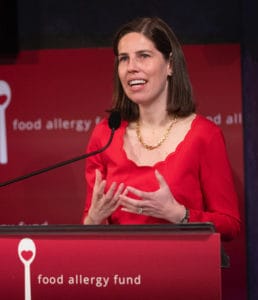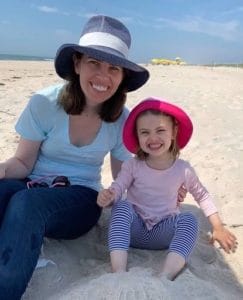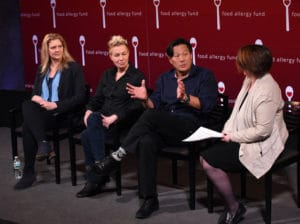
She is a high-powered public relations executive and food allergy mom on a mission. Ilana Golant doesn’t just talk about the need for far more food allergy research. She acts.
In April 2018, Golant launched the Food Allergy Fund, with the ambitious mission to fund research to discover the underlying causes of food allergies and find new treatments for the disease.
A New Yorker transplanted to Washington, D.C., Golant is the managing director of a PR firm and a former executive at NBCUniversal and CNBC. A lawyer by training, this woman knows how to communicate and to collaborate. So when she picked up the phone to leading scientists like microbiologist Dr. Martin Blaser (author of Missing Microbes), allergists Dr. Hugh Sampson, Dr. Wayne Shreffler and several more, they all came on-board her scientific advisory board.
While Golant brings a communication and legal pro’s skills to the table, her interest runs deeply personal. “I have a 3 1/2-year-old daughter who experienced her first anaphylactic reaction at 13 months. Within six months, she tacked on many additional allergens. I was getting increasingly frustrated as a mom that I couldn’t do anything to help her.”
She was determined to effect change, and began her research that led to the Food Allergy Fund. The organization will hold its second FAF Summit in Washington, D.C.
Allergic Living’s Gwen Smith learns more about FAF, the woman behind it and the Summits in the following interview.
Q&A with Ilana Golant
So the Food Allergy Fund starts with a mother’s desire to move the research needle?

IG: Yes, a mother’s determination to make a difference for her daughter. I started thinking: ‘What can I do to get to the bottom of this?’ Not only to help my daughter, but the millions of children and adults who are suffering from from this disease.
As the numbers continue to skyrocket, we still don’t know what is causing this. The lawyer in me spent six months doing due diligence on other disease organizations and proven models of success. I thought, let me see what has worked for other diseases – like juvenile diabetes, crohn’s and colitis, cancer.
My aim was to accelerate research funding and shift, not only the research paradigm, but the national conversation about food allergies. It’s not only to those directly impacted by the disease. Food allergies are now so prevalent that it’s one degree of separation at most for everyone. But we’re still not talking about it in terms of the widespread impact. So that is the genesis of Food Allergy Fund.
With research dollars, food allergy isn’t even in the same ballpark with other diseases, is it?
IG: It isn’t, especially if you look at the size of the patient population. If you take a disease like cystic fibrosis for example – where the patient population is under 40,000 in the U.S. – the research dollars are significantly more than in food allergy. There many diseases where the patient population is significantly smaller, but the research dollars are inversely proportionate to the patient population. It’s important to shift the conversation, so that everyone is mindful of it and aware of it, and it’s not just the community speaking about it.
You really need to engage not only your patient population, but everyone else. For this to truly get to the top of research agendas from a federal funding standpoint and also the corporate research standpoint of getting people to invest the dollars, it’s going to require broad awareness.
Tell us about the mission of the Food Allergy Fund.
IG: The mission is to fund research into the cause of food allergies to improve treatment and, in an ideal world, find a cure at some point.
Right now we’re really focused on: how can we get to a much better fundamental understanding of this disease? That way, we can have better diagnostics, prevention and treatment options, rooted in the underlying cause of this disease. There are certainly many competing theories, and until we figure out the cause, we can’t get to other improvements.
There are several therapy approaches under study, and the immune system is a complex beast. How does the Fund select which research to get behind?
IG: A multi-disciplinary perspective is absolutely critical. When I launched FAF, I was very focused on assembling a scientific advisory board that would represent leading thinkers in the field and then leading thinkers in adjacent fields who need to have a seat at the research table in considering where the dollars should go.
I spent six months learning from the other disease organizations about how to build this multidisciplinary, comprehensive approach. Then I started calling on the leading doctors and scientists across the country – and they all universally said ‘yes, sign me up.’
We funded our first project earlier this year, and the entire SAB [scientific advisory board] reviewed it. We have immunologists, microbiologists, chemical engineers, psychologists, chemical engineers, environmental scientists, among others.
To really achieve breakthroughs, you need these disease experts coming together to have this collaborative mindset. We’ve said let’s accelerate funding, and through increased funding, we can improve collaboration.
There is a lot of competition for funding these days. How are you doing from the funding aspect?
IG: Our Summits are core to that strategy, both in terms of engaging all the relevant stakeholders and creating a thought leader conversation. That doesn’t just benefit the community. It also benefits everyone else in raising awareness and having people come together to address this problem. And I think that’s really important – that we are engaging as much without as we are within.
From a funding standpoint, we funded our first project earlier this year, and we were planning to continue to do an application process roughly twice a year. So we’re gearing up for our next funding round.
Can people get involved at a grassroots level?
IG: Absolutely. We are an entirely volunteer-based organization. So 100 percent of individual donations go directly to research, whether it’s a $5 donation through our website or through Facebook, or a $50,000 donation. It’s really important to me is that if you are a family putting your money towards this, that your money goes directly towards research.
We’ve assembled a small army of amazing volunteers – about 100 people across the country, all of whom are lending their various professional skillsets. We’re able to keep the overhead very limited and to fund operating costs, such as the Summits, through ticket sales and corporate sponsorships.
People can get involved with the FAF through volunteering, or through our social media engagement as well. We’ve done social media campaigns that are large grassroots campaigns. They’ve been covered by the “Today Show” and local media across the country. We’re really trying to have everyone involved in this conversation, since food allergy is one degree of separation.
FAF’s first research project is receiving $100,000 in funding. Can you describe the project?
IG: The first award has been given to a team of 10 collaborators from six institutions. So again, collaboration is really key. They’re going to be studying the guts of infants – with and without food allergies – to determine if the presence of certain lipids in the gut has a protective effect. So looking at these potentially protective lipids in kids with food allergy and in those who have outgrown the disease. They’re going to be looking at both those aspects, with the goal of providing critical data toward developing a new therapeutic approach. Probably within the next 6 to 12 months, there will be significant milestones if not completion of the project.
Let’s talk about the Summits. The first was in New York City in April. Now there’s one coming up on November 14 in Washington, D.C. What’s the main purpose?

IG: The purpose of the Summit is really to bring the food allergy community stakeholders together – patients, advocates, entrepreneurs, doctor, scientists. But we’re also doing it in a very public space and media-focused way to put food allergies front and center as the fastest-growing childhood disease in America.
Our event in New York was sold out. I did not expect to be doing another Summit six months later, but the demand has been so high. And we have an amazing the Summit coming up in D.C. [on November 14]. Our plan is now to do two summits a year. We’re going to be traveling the Summits, but also we are making all the content from them available on our website. So the content and knowledge is widely accessible to all, whether or not you’re able to attend.
The D.C. Summit is going to bring together leading doctors and scientists, advocates, entrepreneurs, celebrity chefs, investors, corporate industry leaders, and members of Congress. It will bring together different parts of the ecosystem together for a very exciting day of conversation.
Any parting thoughts?
IG: I know I didn’t fully get this disease until you live and breathe it every minute of every day. Consciousness-raising is critical because, now as a global community of patients, it’s really imperative that everyone focus on this trend that continues to skyrocket with no slowdown in sight.
It’s really important that we make sure the conversation and and the research momentum is moving towards understanding that this is a global epidemic. it’s almost in some ways a silent epidemic because it hasn’t gotten the attention that it deserves. We’re really hoping to to shine a spotlight.
Learn more about the FAF and the FAF Summit here.
Allergic Living is the national food allergy media sponsor of the D.C. FAF Summit.





